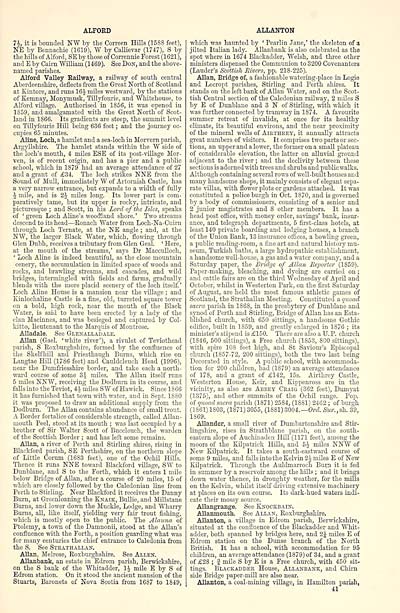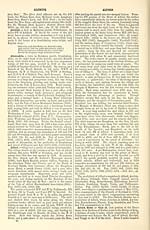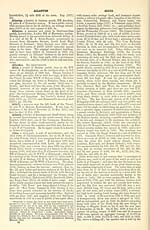Ordnance gazetteer of Scotland > Volume 1
(71) Page 41
Download files
Complete book:
Individual page:
Thumbnail gallery: Grid view | List view

ALFORD
74, it is bounded NW by the Correen HiUs (1588 feet),
NE by Bennachie (1619), W by Callievar (1747), S by
the hills of Alford, SE by those of Corrennie Forest (1621),
and E by Caim William (1469). See Don, and the above-
named parishes.
Alford Valley Railway, a railway of south central
Aberdeenshire, deflects from the Great North of Scotland
at Kintore, and runs 164 miles westward, by the stations
of Kernnay, Monymusk, Tillyfourie, and Whitehouse, to
Alford village. Authorised in 1856, it was opened in
1S59, and amalgamated with the Great North of Scot-
land in 1866. Its gradients are steep, the summit level
on Tillyfourie Hill being 636 feet ; and the journey oc-
cupies 65 minutes.
Aline, Loch, a hamlet and a sea-loch in Morvern parish,
Argyllshire. The hamlet stands within the W side of
the loch's mouth, 4 miles ESE of its post- village Mor-
ven, is of recent origin, and has a pier and a public
school, which in 1879 had an average attendance of 27
and a grant of £34. The loch strikes NNE from the
Sound of Mull, immediately W of Artornish Castle, has
a very narrow entrance, but expands to a width of fully
4, mile, and is 2J miles long. Its lower part is com-
paratively tame, but its upper is rocky, intricate, and
picturesque ; and Scott, in his Lord of the Isles, speaks
of ' green Loch Aline's woodland shore. ' Two streams
descend to its head — Ronach Water from Loeh-Na-Cuirn
through Loch Ternate, at the NE angle ; and, at the
NW, the larger Black Water, which, flowing through
Glen Dubh, receives a tributary from Glen Geal. ' Here,
at the mouth of the streams,' says Dr Macculloch,
' Loch Aline is indeed beautiful, as the close mountain
cenery, the accumulation in limited space of woods and
rocks, and brawling streams, and cascades, and wild
bridges, intermingled with fields and farms, gradually
blends with the more placid scenery of the loch itself. '
Loch Aline House is a mansion near the village ; and
Kinlochaline Castle is a fine, old, turreted square tower
on a bold, high rock, near the mouth of the Black
Water, is said to have been erected by a lady of the
clan Machines, and was besieged and captured by Col-
kitto, lieutenant to the Marquis of Montrose.
Alladale. See Glenalladale.
Allan (Gael, 'white river'), a rivulet of Teviothead
parish, S Roxburghshire, formed by the confluence of
the Skelfhill and Priesthaugh Burns, which rise on
Langtae Hill (1786 feet) and Cauldcleueh Head (1996),
near the Dumfriesshire border, and take each a north-
ward course of some 34 miles. The Allan itself runs
5 miles NNW, receiving the Dodburn in its course, and
falls into the Teviot, 4| miles SW of Hawick. Since 1866
it has furnished that town with water, and in Sept. 1880
it was proposed to draw an additional supply from the
Dodburn. The Allan contains abundance of small trout.
A Border fortalice of considerable strength, called Allan-
mouth Peel, stood at its mouth ; was last occupied by a
brother of Sir Walter Scott of Buccleuch, the warden
of the Scottish Border ; and has left some remains.
Allan, a river of Perth and Stirling shires, rising in
Blackford parish, SE Perthshire, on the northern slope
of Little Corum (1683 feet), one of the Ochil Hills.
Thence it runs NNE toward Blackford village, SW to
Dunblane, and S to the Forth, which it enters 1 mile
below Bridge of Allan, after a course of 20 miles, 15 of
which are closely followed by the Caledonian line from
Perth to Stirling. Near Blackford it receives the Danny
Burn, at Greenloaning the Knaik, Bullie, and Millstane
Burns, and lower down the Muckle, Lodge, and Wharry
Burns, all, like itself, yielding very fair trout fishing,
which is mostly open to the public. The Alauna of
Ptolemy, a town of the Damnonii, stood at the Allan's
confluence with the Forth, a position guarding what was
for many centuries the chief entrance to Caledonia from
the S. See Stbathallan.
Allan, Melrose, Roxburghshire. See Allen.
Allanbank, an estate in Edrom parish, Berwickshire,
on the S bank of the Whitadder, 14, mile E by S of
Edrom station. On it stood the ancient mansion of the
Stuarts, Baronets of Nova Scotia from 1687 to 1849,
ALLANTON
which was haunted by ' Pearlin Jane,' the skeleton of a
jilted Italian lady. Allanbank is also celebrated as the
spot where in 1674 Blackadder, Welsh, and three other
ministers dispensed the Communion to 3200 Covenanters
(Lauder's Scottish Rivers, pp. 218-225).
Allan, Bridge of, a fashionable watering-place in Logie
and Lecropt parishes, Stirling and Perth shires. It
stands on the left bank of Allan Water, and on the Scot-
tish Central section of the Caledonian railway, 2 miles S
by E of Dunblane and 3 N of Stirling, with, which it
was further connected by tramway in 1874. A favourite
summer retreat of invalids, at once for its healthy
climate, its beautiful environs, and the near proximity
of the mineral wells of Aiethrey, it annually attracts
great numbers of visitors. It comprises two parts or sec-
tions, an upper and a lower, the former on a small plateau
of considerable elevation, the latter on alluvial ground
adjacent to the river ; and the declivity between these
sections is adorned with trees and shrubs and public walks.
Although containing several rows of well-built houses and
many handsome shops, it mainly consists of elegant sepa-
rate villas, with flower plots or gardens attached. It was
constituted a police burgh in Oct. 1870, and is governed
by a body of commissioners, consisting of a senior and
2 junior magistrates and 8 other members. It has a
head post office, with money order, savings' bank, insur-
ance, and telegraph departments, 5 first-class hotels, at
least 140 private boarding and lodging houses, a branch
of the Union Bank, 13 insurance offices, a bowling green,
a public reading-room, a fine art and natural history mu-
seum, Turkish baths, a large hydropathic establishment,
a handsome well-house, a gas and a water company, and a
Saturday paper, the Bridge of Allan Reporter (1859).
Paper-making, bleaching, and dyeing are carried on ;
and cattle fairs are on the third Wednesday of April and
October, wdiilst in Westerton Park, on the first Saturday
of August, are held the most famous athletic games of
Scotland, the Strathallan Meeting. Constituted a quoad
sacra parish in 1868, in the presbytery of Dunblane and
synod of Perth and Stirling, Bridge of Allan has an Esta-
blished church, with 650 sittings, a handsome Gothic
edifice, built in 1859, and greatly enlarged in 1876 ; its
minister's stipend is £150. There are also a U.P. church
(1846, 500 sittings), a Free church (1853, 800 sittings),
with spire 108 feet high, and St Saviour's Episcopal
church (1857-72, 200 sittings), both the two last being
Decorated in style. A public school, with accommoda-
tion for 200 children, had (1879) an average attendance
of 178, and a grant of £142, 15s. Airthrey Castle,
Westerton House, Keir, and Kippenross are in the
vicinity, as also are Abbey Ckaig (362 feet), Dumyat
(1375), and other summits of the Ochil range. Pop.
of quoad sacra parish (1871) 2584, (1881) 2462 ; of burgh
(1861)1803, (1871)3055, (1881) 3004.— Orcl.Sur., sh. 39,
1869.
Allander, a small river of Dumbartonshire and Stir-
lingshire, rises in Strathblane parish, on the south-
eastern slope of Auchinaden Hill (1171 feet), among the
moors of the Kilpatrick Hills, and 54, miles NNW of
New Kilpatrick. It takes a south-eastward course of
some 9 miles, and falls into the Kelvin 2 J- miles E of New
Kilpatrick. Through the Auldmarroch Burn it is fed
in summer by a reservoir among the hills ; and it brings
down water thence, in droughty weather, for the mills
on the Kelvin, whilst itself driving extensive machinery
at places on its own course. Its dark-hued waters indi-
cate their mossy source.
Allangrange. See Knookbain.
Allanmouth. See Allan, Roxburghshire.
Allanton, a village in Edrom parish, Berwickshire,
situated at the confluence of the Blackadder and Whit-
adder, both spanned by bridges here, and 2J miles E of
Edrom station on the Dunse branch of the North
British. It has a school, with accommodation for 95
children, an average attendance (1S79) of 34, and a grant
of £28 ; | mile S by E is a Free church, with 450 sit-
tings. Blackadder House, Allanbank, and Chirn
side Bridge paper-mill are also near.
Allanton, a coal-mining village, in Hamilton parish,
41
74, it is bounded NW by the Correen HiUs (1588 feet),
NE by Bennachie (1619), W by Callievar (1747), S by
the hills of Alford, SE by those of Corrennie Forest (1621),
and E by Caim William (1469). See Don, and the above-
named parishes.
Alford Valley Railway, a railway of south central
Aberdeenshire, deflects from the Great North of Scotland
at Kintore, and runs 164 miles westward, by the stations
of Kernnay, Monymusk, Tillyfourie, and Whitehouse, to
Alford village. Authorised in 1856, it was opened in
1S59, and amalgamated with the Great North of Scot-
land in 1866. Its gradients are steep, the summit level
on Tillyfourie Hill being 636 feet ; and the journey oc-
cupies 65 minutes.
Aline, Loch, a hamlet and a sea-loch in Morvern parish,
Argyllshire. The hamlet stands within the W side of
the loch's mouth, 4 miles ESE of its post- village Mor-
ven, is of recent origin, and has a pier and a public
school, which in 1879 had an average attendance of 27
and a grant of £34. The loch strikes NNE from the
Sound of Mull, immediately W of Artornish Castle, has
a very narrow entrance, but expands to a width of fully
4, mile, and is 2J miles long. Its lower part is com-
paratively tame, but its upper is rocky, intricate, and
picturesque ; and Scott, in his Lord of the Isles, speaks
of ' green Loch Aline's woodland shore. ' Two streams
descend to its head — Ronach Water from Loeh-Na-Cuirn
through Loch Ternate, at the NE angle ; and, at the
NW, the larger Black Water, which, flowing through
Glen Dubh, receives a tributary from Glen Geal. ' Here,
at the mouth of the streams,' says Dr Macculloch,
' Loch Aline is indeed beautiful, as the close mountain
cenery, the accumulation in limited space of woods and
rocks, and brawling streams, and cascades, and wild
bridges, intermingled with fields and farms, gradually
blends with the more placid scenery of the loch itself. '
Loch Aline House is a mansion near the village ; and
Kinlochaline Castle is a fine, old, turreted square tower
on a bold, high rock, near the mouth of the Black
Water, is said to have been erected by a lady of the
clan Machines, and was besieged and captured by Col-
kitto, lieutenant to the Marquis of Montrose.
Alladale. See Glenalladale.
Allan (Gael, 'white river'), a rivulet of Teviothead
parish, S Roxburghshire, formed by the confluence of
the Skelfhill and Priesthaugh Burns, which rise on
Langtae Hill (1786 feet) and Cauldcleueh Head (1996),
near the Dumfriesshire border, and take each a north-
ward course of some 34 miles. The Allan itself runs
5 miles NNW, receiving the Dodburn in its course, and
falls into the Teviot, 4| miles SW of Hawick. Since 1866
it has furnished that town with water, and in Sept. 1880
it was proposed to draw an additional supply from the
Dodburn. The Allan contains abundance of small trout.
A Border fortalice of considerable strength, called Allan-
mouth Peel, stood at its mouth ; was last occupied by a
brother of Sir Walter Scott of Buccleuch, the warden
of the Scottish Border ; and has left some remains.
Allan, a river of Perth and Stirling shires, rising in
Blackford parish, SE Perthshire, on the northern slope
of Little Corum (1683 feet), one of the Ochil Hills.
Thence it runs NNE toward Blackford village, SW to
Dunblane, and S to the Forth, which it enters 1 mile
below Bridge of Allan, after a course of 20 miles, 15 of
which are closely followed by the Caledonian line from
Perth to Stirling. Near Blackford it receives the Danny
Burn, at Greenloaning the Knaik, Bullie, and Millstane
Burns, and lower down the Muckle, Lodge, and Wharry
Burns, all, like itself, yielding very fair trout fishing,
which is mostly open to the public. The Alauna of
Ptolemy, a town of the Damnonii, stood at the Allan's
confluence with the Forth, a position guarding what was
for many centuries the chief entrance to Caledonia from
the S. See Stbathallan.
Allan, Melrose, Roxburghshire. See Allen.
Allanbank, an estate in Edrom parish, Berwickshire,
on the S bank of the Whitadder, 14, mile E by S of
Edrom station. On it stood the ancient mansion of the
Stuarts, Baronets of Nova Scotia from 1687 to 1849,
ALLANTON
which was haunted by ' Pearlin Jane,' the skeleton of a
jilted Italian lady. Allanbank is also celebrated as the
spot where in 1674 Blackadder, Welsh, and three other
ministers dispensed the Communion to 3200 Covenanters
(Lauder's Scottish Rivers, pp. 218-225).
Allan, Bridge of, a fashionable watering-place in Logie
and Lecropt parishes, Stirling and Perth shires. It
stands on the left bank of Allan Water, and on the Scot-
tish Central section of the Caledonian railway, 2 miles S
by E of Dunblane and 3 N of Stirling, with, which it
was further connected by tramway in 1874. A favourite
summer retreat of invalids, at once for its healthy
climate, its beautiful environs, and the near proximity
of the mineral wells of Aiethrey, it annually attracts
great numbers of visitors. It comprises two parts or sec-
tions, an upper and a lower, the former on a small plateau
of considerable elevation, the latter on alluvial ground
adjacent to the river ; and the declivity between these
sections is adorned with trees and shrubs and public walks.
Although containing several rows of well-built houses and
many handsome shops, it mainly consists of elegant sepa-
rate villas, with flower plots or gardens attached. It was
constituted a police burgh in Oct. 1870, and is governed
by a body of commissioners, consisting of a senior and
2 junior magistrates and 8 other members. It has a
head post office, with money order, savings' bank, insur-
ance, and telegraph departments, 5 first-class hotels, at
least 140 private boarding and lodging houses, a branch
of the Union Bank, 13 insurance offices, a bowling green,
a public reading-room, a fine art and natural history mu-
seum, Turkish baths, a large hydropathic establishment,
a handsome well-house, a gas and a water company, and a
Saturday paper, the Bridge of Allan Reporter (1859).
Paper-making, bleaching, and dyeing are carried on ;
and cattle fairs are on the third Wednesday of April and
October, wdiilst in Westerton Park, on the first Saturday
of August, are held the most famous athletic games of
Scotland, the Strathallan Meeting. Constituted a quoad
sacra parish in 1868, in the presbytery of Dunblane and
synod of Perth and Stirling, Bridge of Allan has an Esta-
blished church, with 650 sittings, a handsome Gothic
edifice, built in 1859, and greatly enlarged in 1876 ; its
minister's stipend is £150. There are also a U.P. church
(1846, 500 sittings), a Free church (1853, 800 sittings),
with spire 108 feet high, and St Saviour's Episcopal
church (1857-72, 200 sittings), both the two last being
Decorated in style. A public school, with accommoda-
tion for 200 children, had (1879) an average attendance
of 178, and a grant of £142, 15s. Airthrey Castle,
Westerton House, Keir, and Kippenross are in the
vicinity, as also are Abbey Ckaig (362 feet), Dumyat
(1375), and other summits of the Ochil range. Pop.
of quoad sacra parish (1871) 2584, (1881) 2462 ; of burgh
(1861)1803, (1871)3055, (1881) 3004.— Orcl.Sur., sh. 39,
1869.
Allander, a small river of Dumbartonshire and Stir-
lingshire, rises in Strathblane parish, on the south-
eastern slope of Auchinaden Hill (1171 feet), among the
moors of the Kilpatrick Hills, and 54, miles NNW of
New Kilpatrick. It takes a south-eastward course of
some 9 miles, and falls into the Kelvin 2 J- miles E of New
Kilpatrick. Through the Auldmarroch Burn it is fed
in summer by a reservoir among the hills ; and it brings
down water thence, in droughty weather, for the mills
on the Kelvin, whilst itself driving extensive machinery
at places on its own course. Its dark-hued waters indi-
cate their mossy source.
Allangrange. See Knookbain.
Allanmouth. See Allan, Roxburghshire.
Allanton, a village in Edrom parish, Berwickshire,
situated at the confluence of the Blackadder and Whit-
adder, both spanned by bridges here, and 2J miles E of
Edrom station on the Dunse branch of the North
British. It has a school, with accommodation for 95
children, an average attendance (1S79) of 34, and a grant
of £28 ; | mile S by E is a Free church, with 450 sit-
tings. Blackadder House, Allanbank, and Chirn
side Bridge paper-mill are also near.
Allanton, a coal-mining village, in Hamilton parish,
41
Set display mode to: Large image | Transcription
Images and transcriptions on this page, including medium image downloads, may be used under the Creative Commons Attribution 4.0 International Licence unless otherwise stated. ![]()
| Gazetteers of Scotland, 1803-1901 > Ordnance gazetteer of Scotland > Volume 1 > (71) Page 41 |
|---|
| Permanent URL | https://digital.nls.uk/97369618 |
|---|
| Attribution and copyright: |
|
|---|---|

